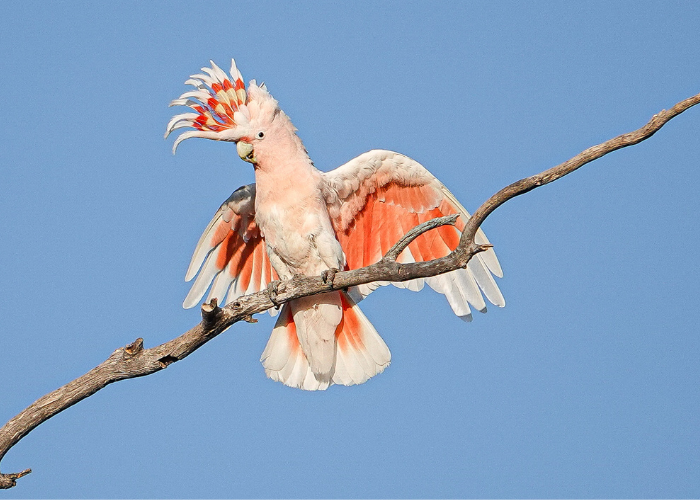Researchers from QUT are using AI and bioacoustic technology to investigate the behaviour and distribution of the Eastern Pink Cockatoo in Queensland (Eastern Major Mitchell’s Cockatoo), an Australian bird recently uplisted to endangered.
Following deployment of acoustic sensors, they have been able to identify hotspots of calling activity and a breeding hollow on Australian Wildlife Conservancy’s (AWC) Bowra Wildlife Sanctuary (Kunja country), near Cunnamulla Queensland.
Professor Susan Fuller from QUT’s School of Biology & Environmental Science, who is overseeing the project, said the research would help give a better understanding of the species’ breeding activity and its requirements for survival.
 Aidan Bowes-McKee
Aidan Bowes-McKee
“The discovery of a hollow is a promising sign that the Pink Cockatoo is breeding on the sanctuary,” Professor Fuller said.
“Despite being uplisted to endangered by the Australian Government in March 2023, not much is known about the species in Queensland and only two scientific papers have been published about the Western Australian subspecies.
“The key for conservation, I believe, is to first understand the species. Where they forage, what species of trees they like to nest in and where they raise their young. Queensland’s high vegetation clearing rate was one of the major causes of the cockatoo’s endangered status, resulting in loss of old hollow-bearing trees.”
In the last four years for which data are available (up to mid-2021), over 450,000 hectares of land was cleared in the Mulga Lands bioregion alone.
“Limited access to tree hollows also increases the competition for appropriate nesting hollows with other birds such as Galahs,” Professor Fuller said.
 Dr Helena Stokes/AWC
Dr Helena Stokes/AWC
Since May 2023, QUT researchers have deployed 22 sensors at Bowra across seven different vegetation types, to help locate areas the birds are using. These sensors are in addition to four permanent solar powered sensors previously installed by the Australian Acoustic Observatory, which have been collecting data since 2019.
AI and bioacoustics technology have the potential to make studying Australian wildlife more efficient, by minimising the need for the research team to live on-site and manually examine over 35,000 hours of audio recordings.
Lola Lange is the QUT master’s student leading the research and analysis. She said one of the major challenges was a lack of ecological knowledge about the birds.
“In Queensland, initial analysis of the data shows that the cockatoos are foraging in different vegetation types and displaying breeding behaviours in multiple tree species,” Ms Lange said.
 Hayden de Villiers/AWC
Hayden de Villiers/AWC
“It’s possible they are investigating hollows that aren’t from one specific tree species like seen in other states. I think they are looking for just the right shape and height.
“However, due to the lack of historical data, I’m unsure if the Queensland Pink Cockatoos’ choice of trees is a result of their limited breeding options or if they select tree species due to their abundance in the area.”
By continuing to analyse acoustic data over the breeding season and upcoming months, Ms Lange and the team can gain more of an idea of how the birds’ habitat usage changes over time.
“Through this we can start to identify key habitat types which are likely to be important for the birds, both at Bowra Wildlife Sanctuary, and across the broader landscape, and learn more about the ecology of this threatened species,” she said.
AI technology and other innovative research systems have opened the door to more effective conservation efforts. For example, AWC similarly plans to implement visual and audio AI bio-acoustic recorders to capture and analyse data in remote areas in western Queensland. The footage will provide insight on the distribution and behaviour of threatened species such as the Plains-wanderer, Bilby and Kowari while monitoring cats, foxes, Dingoes, stocking rates, vegetation, and land-condition in the area.
“Advances in AI, bio-acoustic and camera technology greatly increases our capacity for learning about and monitoring species, particularly in remote areas,” said Dr Helena Stokes, AWC Wildlife Ecologist.
“At Bowra, we’ve been fortunate enough to have visitors and volunteers from Birds Queensland help us to monitor birds for several years, and bio-acoustic recorders are a great additional conservation tool. They help to provide us with greater understanding of Pink Cockatoos and other species, and can help us to tailor management and future research priorities as needed”.
For more information on QUT’s study on the Pink Cockatoos, click here.
Support Australian Wildlife Conservancy's science-led conservation work and safeguard the future of Australia's native species
Donate Now